São Paulo – The exhibition “Taswir, a fotografia árabe contemporânea” (Taswir, contemporary Arab photography) presents a look on the plurality of the whole Arab world, according to participants in the show opening ceremony, which occurred last Thursday (28) night at Instituto Tomie Ohtake in São Paulo. The event brings together works by 14 photographers from 12 countries and runs to April 28.
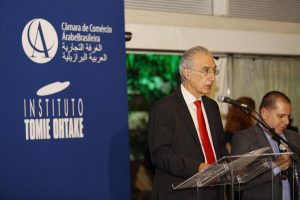
The exhibition celebrates the Arab Community Day in Brazil, March 25, and the 74th anniversary of the League of Arab States. “We have a lot to celebrate,” said the Arab Brazilian Chamber of Commerce president Rubens Hannun. The Arab Brazilian Chamber promotes the show together with the Arab World Institute (AWI) in Paris. The images are part of AWI’s collection.
“We are approximately 12 million [Arabs and descendants] that live in perfect harmony with the Brazilian society,” stressed Hannun. “We’ve contributed to Brazil’s development in almost every sector,” he added. He pointed out that there are no cities in Brazil without someone that talks in Arabic or when you can’t find a sfiha or a kibbeh in some stablishment.”
Commercially, Hannun reported that 22 Arab countries represent the second largest market of Brazilian agribusiness. “In return, Brazil receives products vital for agribusiness,” he said, referring to fertilizers, which are one of the main items Arab nations export to Brazil.
The executive declared, however, that the partnerships between Brazil and the Arab world must be furthered in some key areas. “Like we did with AWI in the cultural area,” he said. The Arab Brazilian Chamber signed a cooperation agreement with the French institute and this photo exhibition is the first product of this partnership. “This is a path that really contributes to mutual knowledge and we are already talking with Mario [Chouery] about other exhibitions in Brazil and, why not, Brazilian exhibitions at AWI,” he said. Chouery is responsible for taking AWI exhibitions abroad and was at the opening of Taswir, which is the first AWI show in Latin America.
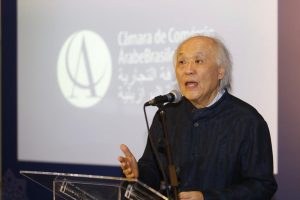
For Hannun, cultural cooperation is one of the foundations of the Arab Brazilian Chamber’s work, “because it supports a permanent trade relation.” “The exhibition Taswir sheds a light on the whole Arab world,” he stressed. “It helps understand a society’s reality,” he concluded.
Instituto Tomie Ohtake president Ricardo Ohtake stressed this is the first time the institute receives an exhibition from the Arab countries, but he pointed out that the cultural interchange between Brazil and that region has occurred “for several decades.” He reminded, for example, the projects made by the Brazilian architect Oscar Niemeyer in Algeria and Lebanon.
“This interchange between Instituto Tomie Ohtake and the Arab Brazilian Chamber was possible thanks to my brother, who signed the project for the Chamber’s office at Paulista Avenue,” he said, referring to the architect Rui Ohtake, who designed not only the entity’s facilities but also the building where it is located in São Paulo. “It is a great interchange, and I’ve already been told other Arab exhibitions will occur here,” he said.
Faith, enthusiasm and passion
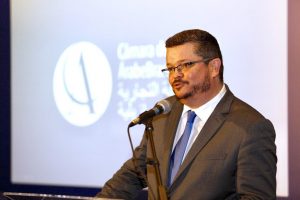
AWI president Jack Lang, France’s former minister of Culture, recorded a video specially for the occasion, which was shown at the opening. “We hope this event will be a huge success and lead us to multiply the initiatives between Brazil and the Arab World Institute,” he declared. He praised the Arab Brazilian Chamber and Instituto Tomie Ohtake for working with “faith, enthusiasm and passion.”
French general-consul in São Paulo, Brieuc Pont, highlighted the show’s extent. “This is a magnificent, ambitious exhibition because it brings together artists that represent the plurality of the Arab world,” he said. “What could be more significant to mark the Arab Community Day?” he pointed out.
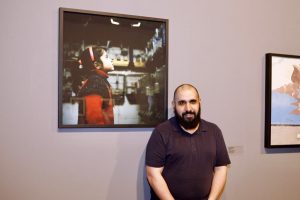
One of the artists, the French-Algerian Lazare Mohamed Djeddaoui, was at the opening ceremony. He made a series inspired in tales from Syria and the Levant region.
For the acting municipal secretary of Foreign Relations Rodrigo Massi, the show “illustrates in a remarkable way the Arab presence in São Paulo city.” “May this exhibition be the first of many, and the city will keep supporting initiatives from the Arab countries,” he stated.
The ambassador of the Arab League in Brazil, Qais Marouf Kheiro Shqair, highlighted the importance of the Arab Brazilian Chamber’s work to fulfill the growth potential of the relations between Brazil and the Arab nations. He pointed out the League was founded in March 22, 1945, then with seven countries. Now there are 22. Hannun highlighted the multilateral entity is represented in Brazil since 1954.
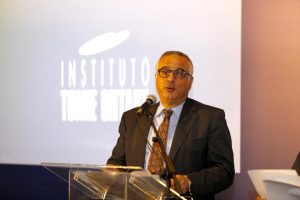
The dean of the Council of Arab Ambassadors in Brazil and Palestinian ambassador Ibrahim Alzeben pointed out that Arabs started migrating to Brazil more than 145 years ago and praised the show. “The Arab Brazilian Chamber works with the same creativity that has always been present in its constant pursue to defend Arab interests in Brazil,” he stressed. He considered the show presents “the essence of the Arab civilization.”
Friendship
The ambassador talked about diplomatic relations with Brazil now. “We did and will do everything in our hands so that Brazil keeps being a friendly country and that the Arab countries keep being friends with Brazil,” stressed Alzeben. “Politics may change, but the countries still exist: 57 invasions went through Palestine and Palestine still exists,” he declared.

The ambassador added that East Jerusalem is the Palestinian capital but will always be free to all. “We won’t accept any violation against our sovereignty from whoever or wherever it may be. Friends don’t attack Palestine, Arabs or Muslims,” he concluded.
In his speech, Ricardo Ohtake said he felt “very honored” to meet the Palestinian representative. “He (Alzeben) told me: ‘We will survive.’ And I want to say that here in Brazil, despite our current situation, we will also survive,” he stated.
Translated by Guilherme Miranda
Jack Lang talks about the exhibition:




